Fox field signs, tracks and trails
Red foxes living in the countryside are not usually easy to observe – generations of mistreatment at the hands of man has seen to that. But many fox field signs are relatively commonplace and provide clues to the habits of these fascinating creatures.
Here are some examples:
Fox paw prints
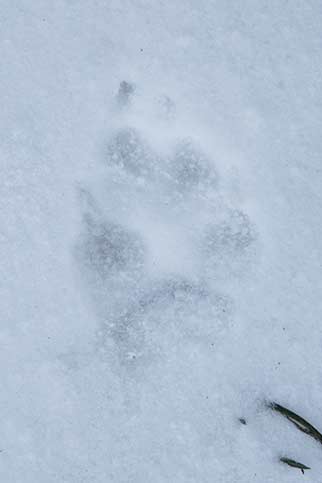
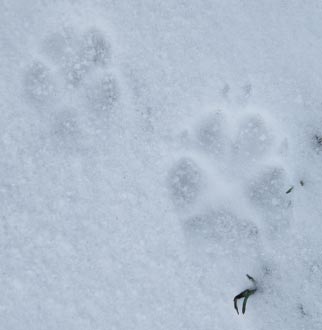
Fox paw prints can sometimes be seen on soft ground although perhaps snow offers the best opportunities for observing animal trails - it's often soft enough for prints to be left yet, especially after a moderate frost, firm enough for prints to be retained whilst the cold weather remains.
But separating fox prints from those of a domestic dog can sometimes be a challenge for both, not surprisingly, can be remarkably similar.
Both fox and domestic dog paws have four toe pads - two in front and one on each side - with a heel to the rear, and both are likely, to greater or lesser extent, to leave claw prints. Fox prints are, however, typically narrower than those left by dogs. Beware, though, for fox prints (and those of other animals) can vary slightly in shape and size, depending upon factors such as the softness of the ground and the speed at which the animal was travelling.
The images illustrate the potential for variety in both shape and size. Both were taken a few feet apart along the same fox trail. The lone print in the larger image and the larger of the two prints in the smaller image are fairly narrow and therefore typical of those left by a fox, whilst the third print is a slightly smaller, rounder example, probably left by a hind foot.
To reduce the potential for confusion, though, it's always useful to remember that fox trails are typically straighter, more purposeful than the often erratic courses taken by dogs.
Fox poo (more politely known as droppings or faeces)
Adult droppings
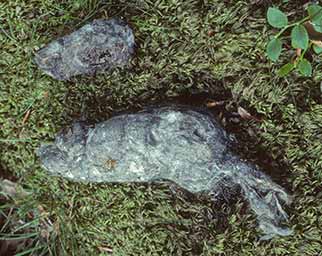
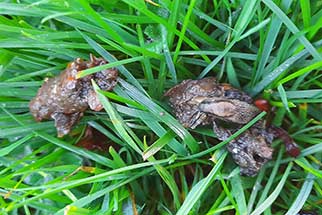
Fox poo, more politely known as droppings or faeces, can often be seen on woodland rides and other paths regularly used by foxes, frequently deposited as territorial markers on raised objects such as mossy hillocks, fallen sticks or molehills.
The droppings are often quite firm, relatively slender, quite long and tapered at the ends, but this is not always the case as, after a period of time, the weather might influence the appearance of the dropping, whilst the fox's recent feeding habits will also be reflected in the characteristics of its faeces. If animals have been on the fox's menu, for example, the presence of fur in the faeces will be visible and will often cause the ends to curl, whilst a recent diet of soft fruit will potentially affect the consistency of the dropping.
The larger of the two images (above) shows a fairly typical fox dropping, whilst the second image shows a softer example (complete with a feasting slug - not a particularly appealing sight, but even slugs have to obtain nutrients from somewhere) that was deposited in wet grass by a fox and had been subsequently rained upon over the following couple of days.
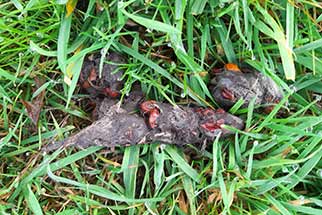
Even without overly close examination, however, fox droppings can usually be seen to have a more tightly packed constituency than those of a domestic dog, they are also usually darker and contain copious amounts of fur, bits of bone and sometimes also feathers, beetle wing cases and the indigestible remains of whatever else the fox has been eating.
The third image, for example, was left by a fox that had clearly been eating berries, probably rosehips.
Fox faeces are also said to have a markedly different smell compared to those left by domestic dogs, but I certainly cannot vouch for this from personal experience.
(Badger faeces are generally squishier - soft, yielding, and usually more liquid - than those of the fox, reflecting the badger's diet, and unlike those of the fox, are often deposited, sometimes repeatedly, in a shallow pit - a latrine).
Cub droppings
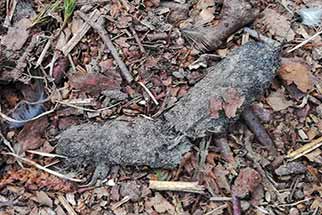
Fox cub's droppings – miniature versions of those left by adults – often betray a fox family’s presence in a nearby den.
The image here shows scattered feathers nearby, whilst fibrous material and bits of bone are visible in the dropping.
(Adult fox droppings are not often found around breeding dens – adults are usually too wary to leave signs such as this, although droppings found in mid- and late-winter, left by a fox as indicators to other foxes of later hoped-for possession, may help to identify the location of likely breeding dens, and, of course, these droppings, much deteriorated, might still be present in spring).
Fox prey remains
Foxes are often messy eaters that frequently leave the remains of prey scattered on the ground. Such items might include, for example:
Rabbit remains
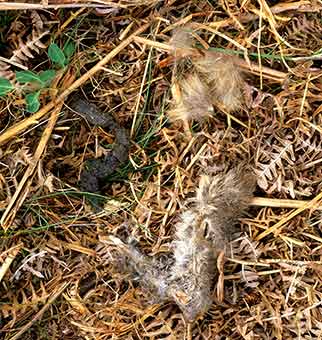
Rabbits, when available, are favourite food items for hungry foxes and their cubs. The illustration here shows the remains of a rabbit left above ground near a foxes' den, and also a dropping left by a cub.
Birds' feathers
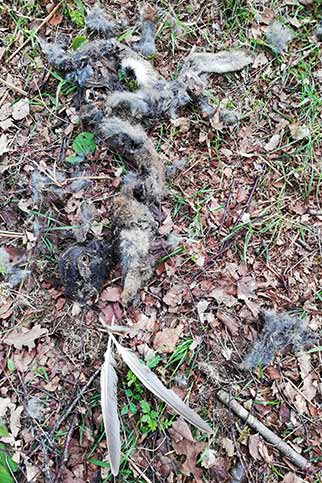
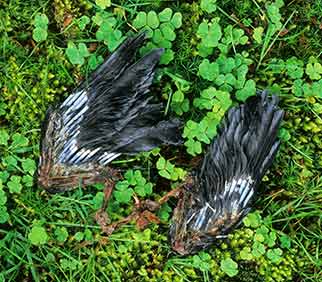
Scattered feathers and other left-over bits and pieces are sometimes found littering the ground– wood pigeon remains are particularly common and also conspicuous.
Quills when bitten off indicate the work of a fox, as birds of prey tend to pluck the feathers without damaging the quills. But as can be seen in the image that includes the remains of a rabbit or squirrel, foxes also sometimes leave the quills intact.
Squirrels' tails
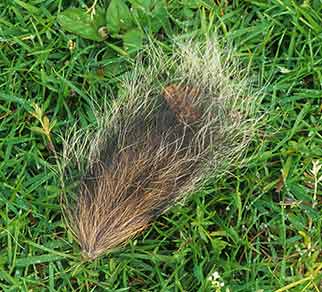
Grey squirrel skins, turned inside out, are also sometimes encountered, and so are the severed tips of squirrels’ tails.
Note, though, that in addition to foxes, buzzards and a range of other predators prey on these animals.
Hedgehog remains
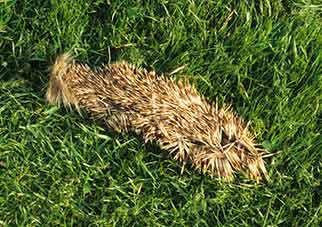
In Britain, along with badgers, foxes are one of the hedgehog’s few natural predators, although it's unlikely that foxes take hedgehogs to any great extent.
Look out, though, for strips of hedgehog spines, the remains of a tasty fox or badger meal. (The bodies of the unfortunate hedgehogs are eaten from beneath, leaving behind only a casing of spines).
Shrews
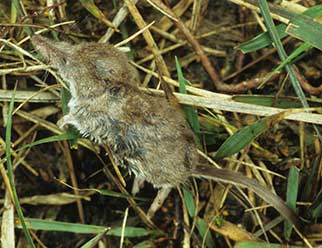
Shrews found dead along the way might indicate the work of a fox, for shrews are thought to be unpalatable and after capture are frequently not devoured - it has been suggested that shrews produce poisonous secretions from their salivary glands and a probably distasteful liquid from skin glands.
(It is also said that foxes are not too keen on eating moles, maybe because soon after death, the mole's flesh rapidly becomes extremely rancid).
Fox scent
Foxes leave scent around their regularly used beats, for example on prominent, raised objects such as mounds of earth, mole hills, large stones and clumps of grass; and along regularly trodden paths and in other well-used areas. Scent so deposited is used to mark out territory; communicate with mates, potential mates and other members of their social group; and to give notice of presence to other foxes and thereby discourage interlopers from encroaching.
Fox scent, associated with faeces, urine and secretions from paired anal sacs, one on either side of the anus, and a supracaudal gland on top of the tail, is sometimes readily discernable to the relatively insensitive human nose - the scent lingers on the air for lengthy periods of time and has a pungent, strongly musky, earthy aroma that is not wholly unpleasant.
In a scene played out by domestic dogs the world over, the accompanying video shows a fox depositing scent on a relatively tall sprig of vegetation and then returning 30 minutes, or so, later to examine its handiwork, or else another remarkably similar fox passes by and picks up the signals left by the scent.
Find out lots more about foxes
References:
Collins Field Guide to the Mammals of Britain and Europe: David Macdonald and Priscilla Barrett
Town fox, Country fox: Brian Vesey-Fitzgerald
Animals Tracks, Trails and Signs: RW Brown, MJ Lawrence, J Pope
Collins Guide to Animal Tracks and Signs: Preben Bang and Preben Dahlstrom
Fauna Britannica: Stefan Buczacki
Running with the Fox: David Macdonald
Fox: Martin Wallen
Wild Fox: Roger Burrows
The Diary of Colonel Peter Hawker
Thirty-five Years in the New Forest: Gerald Lascelles
BBC Wildlife on-line edition
Game and Wildlife Conservation Trust
Wildlife online - fox infanticide
More links
Other related links
Search this site

Sadly, 58 animals were killed - 35 ponies, 13 cows, 8 donkeys and 2 sheep, whilst a further 32 were injured - 3 pigs, 9 donkeys, 11 cows and 9 ponies.
(Forty-three accidents occurred in daylight, 15 at twilight and 101 in the dark. Twenty-seven accidents were not reported by the driver involved).
Here's just one horrific example - Three donkeys killed in collision with van at notorious New Forest blackspot (Advertiser and Times)

